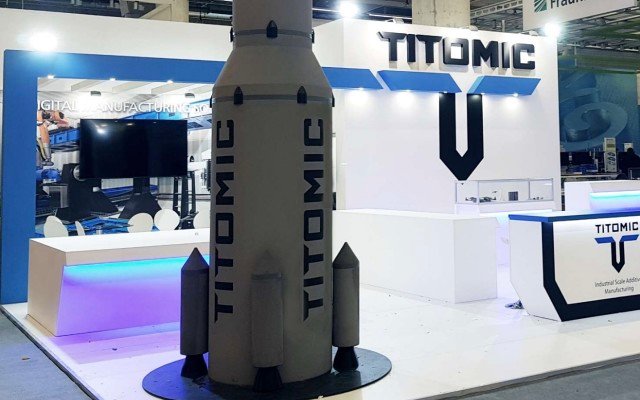The world of additive manufacturing is on the launchpad for lift-off after digital manufacturing solutions company Titomic (ASX: TTT) unveiled a 5.5-metre rocket at FormNext, the world’s premier 3D Printing trade show.
The feat represents the world’s largest additive manufactured titanium part, made in just under 28 hours using Titomic’s kinetic fusion (TKF) technology.
According to Titomic, its technology can also be utilised to manufacture a full-scale space rocket in around 165 hours and achieving build rates of up to 30 kilograms per hour compared to melt-based metal additive manufacturing machines with print volumes of less than 1 kg per hour.
The company’s feat is significant because it opens the door for more efficient construction methods thereby reducing manufacturing costs, expediting build time, and crucially, reducing carbon emissions in global manufacturing.
Titomic claims that it can build a full-scale Gilmour Space ERIS-S rocket in just 165 hours using its TKF process and utilising its economical high-performance titanium and other super alloy powders that can also be applied to ballistic missiles for defence applications.
The company’s managing director Jeff Lang also declared that with titanium powder rapidly falling in price compared to traditional stainless steel, Australia is now at the forefront of actualising a worldwide manufacturing revolution based on additive techniques.
“Previously, titanium was more than twice the price of stainless steel but now with our development of new titanium powder supply chains and Australia’s significant mineral sand resources of approximately 280 million tons of titanium, Titomic is at the forefront of advancing technology to ensure the future sustainability of the earth’s resources whilst reducing carbon emissions for global manufacturing,” said Mr Lang.
Additive manufacturing arms race
Currently, several developed nations are racing to establish industrial manufacturing operations based on additive methods with titanium becoming the go-to metal for additive manufacturers.
Titanium is a highly desirable material in aerospace and defence industries given its combination of lightweight and high strength properties. However, due to its limited supplies and global markets being monopolised by Russian and Chinese production, manufacturing titanium parts is currently cost prohibitive – but things could be about to change as prices decline.
The US, China, Russia, the UK and Germany are current pacesetters although Australia is looking to throw its own hat into the ring courtesy of the Commonwealth Scientific and Industrial Research Organisation (CSIRO), Australia’s leading sciences research organisation with an entire branch focused on industrial, manufacturing and scientific research projects.
One of the CSIRO’s best examples of truly avant-garde and cutting-edge progress is its Lab 22 – a specialised additive manufacturing facility in Melbourne, Australia where the CSIRO is focused on developing titanium-based manufacturing much like Titomic.
The lab’s name (Lab 22) originates from titanium’s atomic number in the periodic table which is fitting considering that Lab 22 works almost exclusively with titanium.
According to the CSIRO, Titomic’s kinetic fusion manufacturing exceeds the requirements of tensile strength as set by ASTM standards. Moreover, Lab 22 works hand-in-hand with several private sector companies in order to establish consistent manufacturing practises and to streamline industry progress.
With titanium as the bellwether for the additive manufacturing industry but facing various macro constraints, Mr Lang said that Titomic has secured several commercial agreements with major organisations for the consistent supply of titanium powder for its operations. In terms of demand, Titomic’s most significant commercial focus for titanium is currently in the piping industry with oil and gas, nuclear, marine and aerospace companies all being targeted.
Titanium provides superior mechanical properties of higher fatigue and tensile strength, lower thermal expansion and specific heat capacity compared to stainless steel. Importantly for the industry, titanium holds nearly three times the thermal shock resistance in comparison to stainless steel making it highly suitable for building rockets.
Titomic says that titanium rockets made with its TKF technology can halve the weight of stainless-steel rockets made with traditional manufacturing methods which allow greater payloads and opens new possibilities for more economic payload deliveries to space.
“TKF allows very large seamless shapes to be produced, highlighting the advances of additive manufacturing not only being improvements in productivity and affordability but also surpass traditional manufacturing methods,” the company said.
